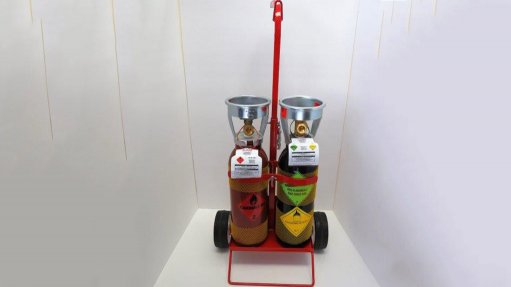
Speciality chemicals supplier A-Gas South Africa launched its new Braze-A-Gas products at FRIGAIR 2018, Africa's largest heating, energy, ventilation, air conditioning and refrigeration exhibition, from 6 to 8 June at Gallagher Convention Centre in Midrand.
Braze-A-Gas has been developed specifically for brazing copper tubes, as well as for welding and cutting. “Here we have ensured that the cylinders are easy to handle, with our standard cylinder valves allowing the use of standard regulators,” A-Gas South Africa National Sales Manager Michael Labacher highlights.
Braze-A-Gas consists of oxygen and acetylene that, when combined, are the engineer’s best choice for brazing copper tubes together in refrigeration and air-conditioning systems. These products produce a flame temperature of about 3 500°C, which is significantly hotter than propane, propylene, or MAPP gas.
“An oxygen-acetylene flame gives good localised heating, with a minimum of waste heat,” Labacher notes. Cylinders are available in a convenient five litres cylinder, providing a portable and economical solution for an array of applications and specific requirements.
Brazing and debrazing (unsweating) best practice are essential for compressor replacement in air-conditioning system service. Any brazing or debrazing must only be carried out after recovery of any excess gas in the system.
This follows the introduction of an inert gas such as Oxygen Free Nitrogen (OFN) into the pipework. It is critical to expel oxygen from the internal system so as to prevent flash-ignition of hot oil, a particular problem when debrazing welded connections on replacement compressors. OFN, in particular, inhibits oxidisation of internal copper pipes and fittings when brazing.
“This is why A-Gas South Africa promotes best practice in this regard, which entails making engineers and technicians aware of the potential for fire during brazing operations,” Labacher adds. Gloves and goggles should be worn as standard Personal Protective Equipment (PPE), while an adequate risk assessment also needs to be carried out. A dry-powder fire extinguisher must be on hand at all times during hot works.
“Technicians are often unaware of products on the market that can assist them in the field, such as our Braze-A-Gas. For example, A-Gas South Africa not only offers a wide range, but can supply recovery cylinders to capture unwanted gas for recovery or destruction, as well as handy portable-sized OFN cylinders for purging and pressure testing,” Labacher concludes.